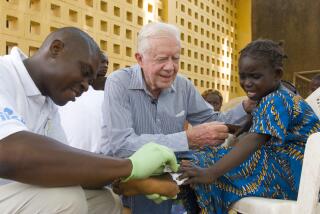WHERE THE CANDIDATES STAND ON AIDS
- Share via
Background: As HIV infections and AIDS deaths rose dramatically in the past decade, pressure mounted on federal officials to make the fight against AIDS a top priority. But calls for increased research have encountered pinched budgets. Some preventive proposals, such as distributing condoms in schools, have proven highly controversial.
President Bush has expressed personal sympathy for AIDS patients and vowed to press the fight against the disease, but critics say his proposal for spending $873 million on AIDS research in 1993 will not even keep up with inflation. The Bush Administration classifies AIDS as a disease that can be controlled by personal behavior. Bush has condemned giving condoms to teen-agers and opposes clean needle-exchange programs for intravenous drug users.
Patrick J. Buchanan has written in past syndicated columns that the AIDS crisis is caused by the willful refusal of homosexuals to cease indulging in anal intercourse. He does not favor increased funding for AIDS and is opposed to distributing condoms to teen-agers.
Bill Clinton supports the recommendations of the President’s Commission on AIDS, including development of a plan to identify priorities and fully fund a large federal effort. He supports appointment of an AIDS czar to oversee federal response to the epidemic. He contends that the key to fighting AIDS is through education, and that the cost of the AIDS problem should be born as a part of a national health plan. He supports distribution of condoms to teen-agers.
Edmund G. (Jerry) Brown Jr. also supports more money for AIDs research and education. He opposes mandatory testing for the HIV virus. He contends that people infected with HIV should have a greater voice in determining what kind of research is done. Alone among the candidates, Brown wears a a red ribbon to call attention to the disease. Brown supports distribution of condoms to teen-agers.
Number of AIDS cases in the United States 1981: 188 1982: 652 1983: 2,080 1984: 4,442 1985: 8,215 1986: 13,150 1987: 21,109 1988: 30,754 1989: 33,638 1990: 41,616 1991: 43,672 Source: Centers for Disease Control
More to Read
Sign up for Essential California
The most important California stories and recommendations in your inbox every morning.
You may occasionally receive promotional content from the Los Angeles Times.










